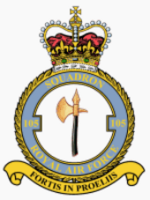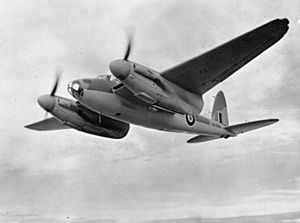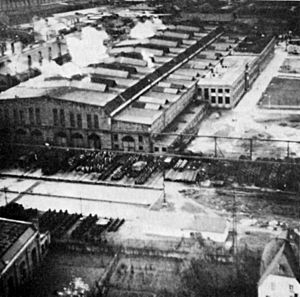No. 105 Squadron RAF facts for kids
Quick facts for kids No. 105 Squadron RAF |
|
|---|---|

No. 105 Squadron badge
|
|
| Active | 23 Sep 1917 - 1 Feb 1920 12 Apr 1937 - 1 Feb 1946 21 Feb 1962 – 20 Jan 1968 |
| Country | |
| Branch | |
| Nickname(s) | "Hereford's own Squadron" |
| Motto(s) | Latin: Fortis in Proeliis ("Valiant in battles") |
| Commanders | |
| Notable commanders |
|
| Insignia | |
| Squadron Badge heraldry | A battle axe The battle axe commemorates the fact that at one time the squadron was equipped with Battle aircraft. The emerald green handle of the axe signifies the squadron's service in Ireland. |
| Squadron Codes | MT (Oct 1938) GB (Sep 1939 - Jan 1946 ) |
No. 105 Squadron was a special flying group of the Royal Air Force (RAF). It was active during three different time periods between 1917 and 1969.
The squadron first started during World War I as part of the Royal Flying Corps. It was later shut down after the war ended. It was brought back to life just before World War II. After that war, it stopped flying again.
During its second period, No. 105 Squadron was a bomber unit. It was the very first group to use the fast de Havilland Mosquito light bomber. In the 1960s, it was reactivated for six years. Its job then was to carry supplies and troops for the British Army in places like the Aden Protectorate and the Far East.
Contents
History of No. 105 Squadron
How the Squadron Started
No. 105 Squadron of the Royal Flying Corps began on September 23, 1917. It formed at RAF Waddington and soon moved to RAF Andover. There, pilots trained with different planes to become a bomber squadron.
Before they could start their missions, the squadron moved to Omagh, County Tyrone, in Ireland. They flew RE8 biplanes. Their main jobs were to look for enemy submarines and scout areas from the sky.
Within a year, they got new planes, the Bristol F2B Fighter. Even after the war ended in 1918, No. 105 Squadron stayed in Ireland. They continued their duties until February 1, 1920. At that time, the squadron was officially closed down. Its members and planes became part of 2 Squadron.
Reforming for World War II
No. 105 Squadron was formed again on April 12, 1937. This happened at RAF Harwell. It started as a day bomber squadron. At first, they used Hawker Audax biplanes. These were older planes, and the squadron was waiting for newer ones.
Modern Fairey Battle monoplanes arrived in August 1937. No. 105 Squadron was one of the first groups to fly these new aircraft.
Fighting in France and England
When World War II began in September 1939, the squadron moved to France. They were part of the Advanced Air Striking Force. Their first missions were to scout along the border between France and Germany.
In May 1940, German forces invaded France. The squadron became very busy attacking the advancing German troops. One important mission was bombing bridges over the River Meuse. This was an attempt to slow down the German advance.
The squadron faced heavy attacks from German fighter planes. Because of this, they had to return to England in June 1940.
Defending Against Invasion
Back in England, at RAF Honington, the squadron received new planes. They were now equipped with Bristol Blenheim bombers. They joined 2 Group to attack German shipping and ports. These attacks aimed to stop a possible German invasion of Britain.
The squadron suffered many losses during these missions. German anti-aircraft guns, called Flak, caused a lot of damage. In October 1940, some of the squadron went to Malta. Their job there was to attack enemy ships in the Mediterranean Sea.
The squadron later moved to RAF Swanton Morley in Norfolk. In 1941, their commanding officer was lost during a raid. A new leader, Wing Commander H.I. Edwards, took over. He was awarded the Victoria Cross for bravely planning and leading a low-level attack on the port of Bremen.
The Mosquito Era
In October 1941, the part of the squadron that was in Malta came back to England. The squadron then started to fly fewer missions. This was because they were chosen to be the first to use the new Mosquito Mk.IV aircraft. They spent time training with these advanced planes.
In December, the squadron moved to RAF Horsham St Faith near Norwich. The Mosquito was a very fast and versatile plane.
On July 2, 1942, No. 105 Squadron attacked submarine yards in Flensburg, Germany. Wing Commander Alan Robertson Oakeshott DFC flew a Mosquito FB Mk. IV on this mission. He successfully dropped bombs on the submarine slipways. Shortly after, his plane was shot down by a German fighter. Both he and his observer were killed.
The squadron faced more challenges. Their commanding officer, Wing Commander Geoffrey Longfield, was killed during a raid on Rennes in February 1943. His replacement, Wing Commander John William Deacon, died in a training accident the very next day.
Precision Attacks and Pathfinder Role
One early Mosquito mission was a high-level attack on Cologne. This was after a massive "thousand-bomber" raid on the city. However, this wasn't the best way to use the new Mosquito.
The squadron soon switched to low-level, precise attacks. The Mosquito was excellent for these missions. The first such attack was on the Gestapo Headquarters in Oslo on September 25, 1942. The squadron was also the first to carry out a daylight raid on Berlin on January 30, 1943.
By June 1943, the squadron joined No. 8 (Pathfinder) Group. They upgraded to Mosquito Mk.IXs equipped with a special navigation system called Oboe. Their job was to mark targets precisely for other Bomber Command planes. They continued this important work until the war ended. No. 105 Squadron was officially closed down at RAF Upwood on February 1, 1946.
After the Wars
Between 1949 and 1957, No. 105 Squadron was combined with 109 Squadron. They were known as 109/105 Squadron.
However, on February 21, 1962, No. 105 Squadron started up again on its own. This happened at RAF Benson. They flew the Armstrong Whitworth Argosy, a plane used for carrying things over medium distances.
By June, the squadron had moved to RAF Khormaksar, in Aden. Their job was to support ground troops in that area. They also flew transport missions across the Middle East and parts of Africa. They helped by paradropping supplies to the British Army during operations in the Radfan. They also supported operations in Borneo.
In 1966, they were again supporting troops in Aden. As unrest grew, they also helped with search-and-rescue missions. These searches took place over the Indian Ocean and the Red Sea. As Britain prepared to leave Aden, the squadron moved to Muharraq, Bahrain, in 1967. On January 20, 1968, the squadron was officially closed down for the last time.
Aircraft Used by No. 105 Squadron
| From | To | Aircraft | Variant | Notes |
|---|---|---|---|---|
| September 1917 | April 1918 | Various | Airco DH.6, Royal Aircraft Factory B.E.2, Airco DH.9 | |
| April 1918 | January 1919 | Royal Aircraft Factory R.E.8 | ||
| December 1918 | February 1920 | Bristol F2B Fighter | ||
| April 1937 | October 1937 | Hawker Audax | ||
| August 1937 | June 1940 | Fairey Battle | Mk.I | |
| June 1940 | May 1942 | Bristol Blenheim | Mk.IV | |
| November 1941 | March 1944 | de Havilland Mosquito | Mk.IV | |
| July 1943 | February 1945 | de Havilland Mosquito | Mk.IX | |
| March 1944 | February 1946 | de Havilland Mosquito | Mk.XVI | |
| January 1962 | January 1968 | Armstrong Whitworth Argosy | C.1 |
Images for kids
See also
- Hughie Edwards
- Thomas W. Horton
- John Wooldridge







